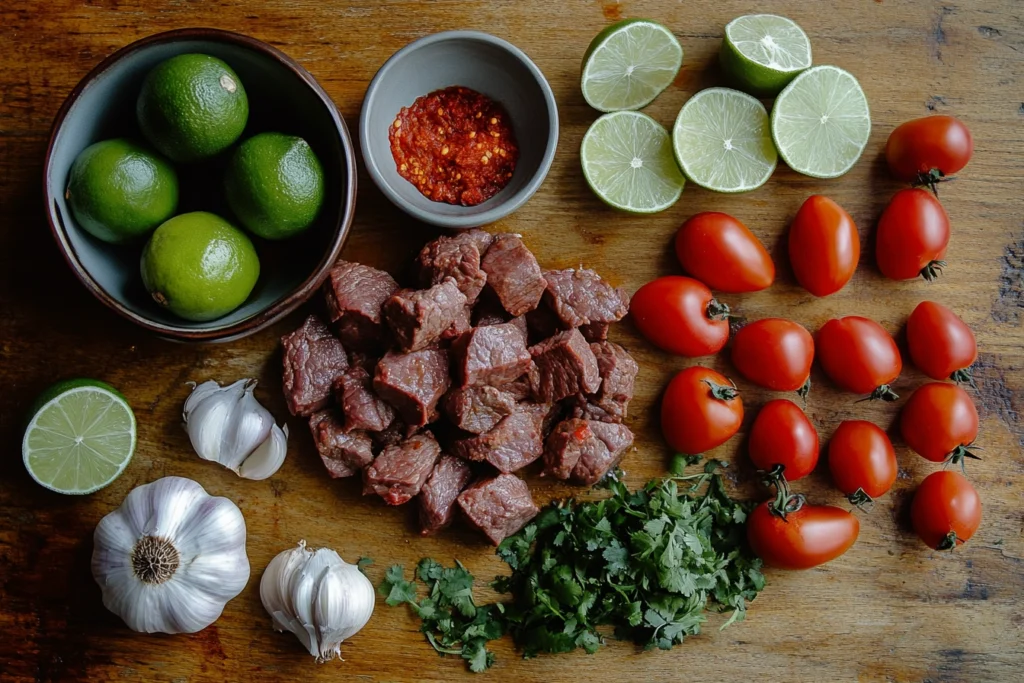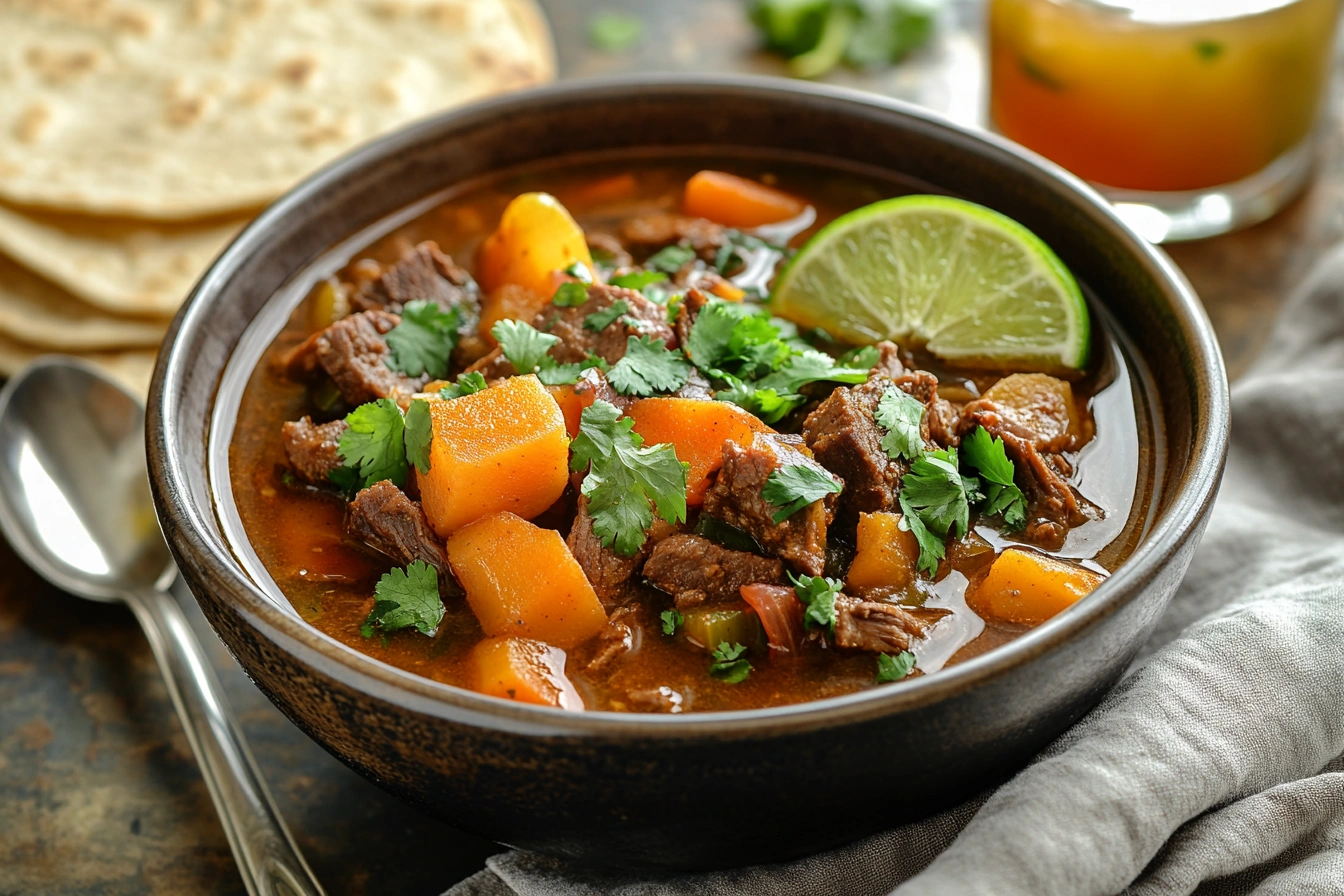Introduction
Mexican Beef Stew is a rich, hearty dish that combines tender beef with bold, authentic flavors from traditional Mexican spices and fresh vegetables. Perfect for family dinners or meal prepping, this stew is as versatile as it is delicious. Whether you’re looking for a comforting meal or a way to impress guests with a taste of Mexico, this recipe has got you covered. In this article, we’ll explore every aspect of making the perfect Mexican Beef Stew—from selecting the right ingredients to creating variations for every taste.
The Rich History of Mexican Beef Stew
The Origins of Mexican Beef Stew
Mexico’s culinary tradition is deeply rooted in history, with dishes that blend indigenous ingredients and techniques with influences from Spanish colonization. Mexican Beef Stew embodies this fusion, offering a dish that’s both nourishing and packed with flavor.
Why This Dish Stands Out
The hallmark of this stew lies in its simplicity and flexibility. It allows home cooks to use whatever fresh ingredients they have while maintaining its unique essence. The combination of aromatic spices and tender beef makes it a timeless favorite.
Cultural Significance
In Mexico, beef stews like caldo de res or guisados are a staple, served at family gatherings and celebrations. They symbolize warmth, comfort, and the joy of sharing a meal with loved ones.
Essential Ingredients for Mexican Beef Stew
The Building Blocks of Flavor
Creating the perfect Mexican Beef Stew starts with the right ingredients. Each component contributes to the dish’s depth and complexity:
- Beef
- Cut of Meat: Chuck roast or beef shank are ideal for their marbling and tenderness.
- Preparation: Cut into bite-sized pieces for even cooking.
- Vegetables
- Potatoes: Add heartiness and soak up the flavors.
- Carrots: Provide sweetness and color.
- Zucchini: Adds freshness and a tender bite.
- Tomatoes: Serve as the stew’s base for acidity and richness.
- Aromatic Spices and Herbs
- Garlic and Onion: Essential for the stew’s flavor foundation.
- Cumin: Adds a warm, earthy undertone.
- Oregano: Brings herbal brightness.
- Bay Leaves: Enhance the broth with subtle depth.
- Chilies
- Dried Chilies (e.g., Guajillo, Ancho): Rehydrate and blend for a smoky, rich flavor.
- Fresh Jalapeños or Serranos: Add heat and freshness.
- Broth and Seasoning
- Beef Broth: The liquid base for richness.
- Salt and Pepper: Adjust to taste.
For another hearty Mexican dish, check out our recipe for Mexican Chicken Salad, which perfectly complements the stew’s bold flavors.
Optional Additions
- Corn or hominy for a rustic feel.
- Lime juice for a tangy finish.
- Fresh cilantro for garnish.
Preparing the Ingredients for Mexican Beef Stew
1: Prepping the Beef
- Trim Excess Fat: Remove large chunks of fat while keeping enough for flavor.
- Cut into Cubes: Ensure uniform pieces for even cooking.
- Season Generously: Sprinkle salt, pepper, and a pinch of cumin on the beef cubes.
2: Preparing the Vegetables
- Potatoes
- Peel and dice into medium-sized chunks to avoid overcooking.
- Carrots
- Slice into thick rounds for a firm texture in the stew.
- Zucchini
- Chop into bite-sized pieces, keeping them slightly larger to maintain texture.
- Tomatoes
- Blanch, peel, and dice to make a smooth stew base.
3: Working with Chilies
- Dried Chilies
- Rehydrate: Soak in hot water for 15–20 minutes until soft.
- Blend: Combine with garlic, onion, and a splash of broth to create a chili paste.
- Fresh Chilies
- Slice: Remove seeds for milder heat or leave them in for more spice.
4: Preparing Aromatics and Herbs
- Onions and Garlic: Mince or finely chop for an even distribution in the stew.
- Herbs: Keep bay leaves whole for easy removal and chop cilantro for garnish.
5: Ready the Broth
- Use a rich beef broth for depth, and warm it up slightly to avoid cooling the stew during cooking.

Cooking the Perfect Mexican Beef Stew
1: Searing the Beef
- Heat the Pan: Add a tablespoon of oil to a large, heavy-bottomed pot or Dutch oven over medium-high heat.
- Sear in Batches: Brown the beef cubes on all sides, ensuring they develop a golden crust. Avoid overcrowding the pan to prevent steaming.
- Set Aside: Transfer the browned beef to a plate.
2: Sautéing the Aromatics
- Add Aromatics: In the same pot, sauté onions, garlic, and a pinch of salt until softened and fragrant.
- Incorporate the Chili Paste: Pour in the blended chili mixture, stirring frequently for about 3–5 minutes until the paste thickens and the raw chili flavor mellows.
3: Building the Flavor Base
- Add Spices: Sprinkle in cumin, smoked paprika, and oregano, stirring to combine.
- Deglaze the Pot: Pour a cup of broth or water to lift any browned bits from the bottom of the pot. These bits add a deep, savory flavor.
4: Simmering the Stew
- Return the Beef: Add the seared beef cubes back into the pot.
- Pour the Broth: Add enough broth to cover the beef and bring the mixture to a boil.
- Reduce Heat: Lower the heat to a simmer and cover with a lid. Cook for about 1.5–2 hours, stirring occasionally.
5: Adding Vegetables
- Layer in Hard Vegetables: Add potatoes and carrots first, as they take longer to cook. Simmer for 20 minutes.
- Add Soft Vegetables: Incorporate zucchini and any fresh chilies, cooking for an additional 10–15 minutes.
- Adjust Seasoning: Taste and add salt, pepper, or a dash of lime juice for brightness.
6: Thickening the Stew
- For a thicker consistency, mash a few potato chunks directly in the pot or let the stew reduce uncovered for a few extra minutes.
7: Finishing Touches
- Herb Garnish: Sprinkle freshly chopped cilantro over the stew.
- Optional Enhancements: Add a dollop of sour cream or grated cheese for richness.
Cooking this stew to perfection involves a careful balance of spices and a slow simmer to tenderize the meat. Consider serving it alongside warm tortillas or fluffy Cilantro Lime Rice for a complete meal. The combination of these dishes showcases the rich variety of Mexican cuisine.
Serving and Enjoying Mexican Beef Stew
Plating the Mexican Beef Stew
- Choose the Right Dish: Serve the stew in deep bowls to keep the warmth intact and showcase the rich broth.
- Ladle Generously: Scoop a mix of tender beef, vegetables, and broth for a hearty serving.
- Garnish Creatively: Add fresh cilantro, thinly sliced radishes, or a dollop of sour cream for visual appeal and flavor enhancement.
Pairing Suggestions
- With Fresh Tortillas: Warm corn or flour tortillas on the side are perfect for dipping into the flavorful broth.
- Over Rice: Serve the stew atop a bed of fluffy Mexican rice for a satisfying meal.
- With Bread: Crusty bread or bolillo rolls can soak up the rich, savory broth.
Sides That Complement Mexican Beef Stew
- Avocado Salad: A light salad with sliced avocado, lime, and a sprinkle of salt balances the rich stew.
- Black Bean Dip: Serve alongside the stew for a protein-packed side option.
- Pickled Vegetables: Add a tangy kick with quick-pickled jalapeños or carrots.
Beverages That Pair Well
- Non-Alcoholic Drinks: Offer refreshing drinks like hibiscus tea (agua de Jamaica), horchata, or limeade.
- Herbal Infusions: Warm chamomile or mint tea complements the rich, hearty flavors.
Variations of Mexican Beef Stew
Regional Variations of Mexican Beef Stew
- Northern Mexico Style:
- Features dried chilies like guajillo or ancho for a smoky depth.
- Commonly includes potatoes and carrots as hearty fillers.
- Central Mexico Style:
- Focuses on a lighter broth flavored with fresh tomatoes and herbs.
- Often accompanied by avocado slices and lime wedges.
- Coastal Mexico Style:
- Incorporates seafood such as shrimp or crab along with beef for a unique surf-and-turf approach.
- Coconut milk or plantains may be added for tropical flair.
Creative Additions to the Traditional Recipe
- Vegetable-Forward Stew:
- Add zucchini, corn, or green beans for a more veggie-centric version.
- Swap beef for jackfruit or tofu to make it vegetarian.
- Spicy Beef Stew:
- Enhance heat with habanero peppers or extra chili powder.
- Serve with a cooling side like yogurt or crema.
- Smoky Barbecue-Style Stew:
- Infuse a smoky flavor by using smoked paprika or chipotle peppers.
- Pair with grilled bread or smoked cheese on the side.
Global Twists on Mexican Beef Stew
- Tex-Mex Fusion:
- Add cheddar cheese and serve with nacho chips for a fun twist.
- Include beans like pinto or kidney beans for a heartier dish.
- Asian-Inspired Beef Stew:
- Add soy sauce, ginger, and scallions for a fusion of flavors.
- Serve with jasmine rice or udon noodles.
- Mediterranean Flair:
- Use olives, capers, and a splash of lemon juice to brighten the dish.
- Pair with warm pita bread or couscous.
For those looking to explore more protein-packed options, try incorporating elements from our Herb-Crusted Beef Tenderloin Recipe. This adaptation introduces new textures and flavors to your traditional stew. Alternatively, for a fusion twist, pair it with the smokiness of our Beef Back Ribs Recipe.
Serving Suggestions for Mexican Beef Stew
Perfect Sides to Complement Mexican Beef Stew
- Classic Tortillas:
- Serve with warm corn or flour tortillas for scooping or dipping into the stew.
- Consider making homemade tortillas for an authentic touch.
- Rice Dishes:
- Pair with cilantro lime rice or traditional Mexican red rice.
- For a lighter option, serve with cauliflower rice or quinoa.
- Hearty Breads:
- Accompany the stew with crusty bread or Mexican bolillos for a satisfying meal.
- Toasted garlic bread works well for soaking up the rich broth.
- Fresh Salads:
- Serve alongside a simple cucumber and tomato salad with a lime vinaigrette.
- Mexican street corn salad adds a refreshing, tangy contrast.
Topping Ideas for a Customized Experience
- Fresh Herbs and Greens:
- Garnish with cilantro, parsley, or green onions for a burst of freshness.
- Add arugula or spinach for a subtle peppery flavor.
- Dairy-Based Toppings:
- Add dollops of sour cream or crema for a creamy, tangy finish.
- Sprinkle shredded cheddar, Monterey Jack, or cotija cheese for added richness.
- Zesty Additions:
- Squeeze fresh lime juice over the stew to brighten the flavors.
- Top with pickled onions or jalapeños for a tangy, spicy kick.
- Crunchy Textures:
- Add crushed tortilla chips or crispy fried onions for crunch.
- Sprinkle roasted pumpkin seeds (pepitas) for a nutty element.
Beverage Pairings for a Balanced Meal
- Refreshing Non-Alcoholic Drinks:
- Try a chilled hibiscus tea (agua de jamaica) or a tamarind refresher.
- Pair with horchata for a creamy, cinnamon-infused drink.
- Warm Comforts:
- Enjoy with a cup of Mexican hot chocolate or spiced tea on cooler days.
- Simple Hydration:
- Serve with sparkling water infused with lime or cucumber slices for a clean, refreshing pairing.
Storing and Reheating Mexican Beef Stew
How to Properly Store Leftover Stew
- Cool Down Quickly:
- Allow the stew to cool to room temperature before storing to avoid condensation and spoilage.
- Choose the Right Containers:
- Use airtight containers or heavy-duty freezer bags for proper storage.
- Divide the stew into individual portions for easy reheating later.
- Refrigeration:
- Store in the refrigerator for up to 4 days.
- Ensure the container is tightly sealed to preserve freshness and prevent cross-contamination.
- Freezing:
- Freeze for up to 3 months in freezer-safe containers.
- Label each container with the date for easy tracking.
Tips for Reheating Mexican Beef Stew
- On the Stovetop:
- Transfer the stew to a saucepan and heat over medium heat, stirring occasionally.
- Add a splash of broth or water if the stew has thickened during storage.
- Using a Microwave:
- Place the portioned stew in a microwave-safe dish.
- Cover with a microwave-safe lid or wrap to retain moisture.
- Heat in 1- to 2-minute intervals, stirring in between for even warming.
- In the Oven:
- Reheat in a covered oven-safe dish at 350°F (175°C) for about 20-30 minutes.
- Add a little liquid to maintain the stew’s consistency.
- Avoid Overheating:
- Overcooking during reheating can cause the meat to become tough. Heat just until warmed through.
Leftovers of this stew are perfect for meal prepping or repurposing into new dishes. Transform it into tacos with tips from our Chicken Quesadilla Recipe or use it as a flavorful topping for nachos.
Refreshing the Flavors After Storage
- Add Fresh Garnishes:
- Top with freshly chopped cilantro, green onions, or a squeeze of lime to revive the flavors.
- Adjust Seasonings:
- Taste and adjust salt, pepper, or spices as needed to refresh the stew.
- Incorporate New Elements:
- Mix in freshly cooked vegetables or beans to enhance the flavor and texture of reheated portions.
Creative Ways to Use Leftover Mexican Beef Stew
- Taco Filling:
- Shred the beef and use it as a filling for tacos, topped with cheese and salsa.
- Stuffed Peppers:
- Fill bell peppers with reheated stew, top with cheese, and bake until the peppers are tender.
- Over Rice or Pasta:
- Serve the stew over rice, quinoa, or even pasta for a quick and hearty meal.
- Loaded Nachos:
- Use the stew as a topping for tortilla chips, adding shredded cheese, jalapeños, and sour cream for a fun snack.
Frequently Asked Questions (FAQs) About Mexican Beef Stew
1. What Cut of Beef Is Best for Mexican Beef Stew?
The best cuts of beef for Mexican beef stew are chuck roast, beef shank, or short ribs. These cuts are rich in marbling and collagen, which break down during slow cooking, resulting in tender, flavorful meat.
2. Can I Make Mexican Beef Stew in a Slow Cooker or Instant Pot?
Yes, both methods work wonderfully:
- Slow Cooker: Sear the beef first for extra flavor, then combine all ingredients and cook on low for 8–10 hours or on high for 4–6 hours.
- Instant Pot: Use the sauté function to brown the beef, then pressure cook on high for 35–40 minutes. Let the pressure release naturally for the best texture.
3. How Can I Adjust the Spice Level in the Stew?
- To make it milder, use fewer chili peppers or substitute them with mild options like poblano peppers.
- For a spicier stew, add diced jalapeños, serrano peppers, or a pinch of cayenne pepper.
4. Can I Make This Stew Ahead of Time?
Yes! In fact, the flavors develop even more after sitting:
- Store the stew in an airtight container in the refrigerator for up to 3 days.
- Reheat on the stovetop or in a microwave, adding a splash of broth if needed to restore its consistency.
5. What Sides Pair Best With Mexican Beef Stew?
- Rice: Serve the stew over steamed white or Mexican rice to soak up the rich broth.
- Tortillas: Warm flour or corn tortillas make an excellent accompaniment for dipping.
- Salads: A fresh green salad with lime vinaigrette adds a refreshing contrast.
6. Is Mexican Beef Stew Gluten-Free?
Yes, the traditional recipe is naturally gluten-free. However, if you’re using pre-made stock or sauces, ensure they are certified gluten-free.
7. Can I Freeze Mexican Beef Stew?
Absolutely! Let the stew cool completely, then transfer it to freezer-safe containers. It can be frozen for up to 3 months. Thaw overnight in the refrigerator before reheating.
8. Can I Use Different Proteins Instead of Beef?
Certainly:
- Replace beef with chicken thighs for a lighter version.
- Use pork shoulder for a rich and flavorful alternative.
- For a vegetarian option, substitute the beef with hearty vegetables like mushrooms, zucchini, or sweet potatoes and use vegetable broth.
9. How Can I Thicken the Stew?
To thicken the stew:
- Mash a few of the cooked potatoes and stir them back into the pot.
- Mix a tablespoon of cornstarch with two tablespoons of water, then add it to the simmering stew, stirring until thickened.
10. Can I Add Beans to Mexican Beef Stew?
Yes, adding beans like black beans or pinto beans can enhance the dish’s heartiness and texture. Add cooked beans in the last 20 minutes of cooking to prevent overcooking.
Conclusion
Mexican beef stew is more than just a dish—it’s a comforting embrace of bold flavors, hearty textures, and cultural heritage. Whether it’s served on a chilly evening or as the centerpiece of a family gathering, this stew brings people together with its vibrant spices and soul-warming qualities.
From its tender beef and robust vegetables to its rich, flavorful broth, this dish embodies the heart of Mexican cuisine. With countless ways to customize and serve it, Mexican beef stew is as versatile as it is delicious. Whether you stick to the classic recipe or experiment with creative twists, you’re guaranteed a crowd-pleaser every time.
As you recreate this culinary delight in your kitchen, remember to make it your own. Add your favorite toppings, incorporate unique ingredients, and enjoy the journey of exploring a timeless recipe. No matter how it’s prepared, Mexican beef stew is sure to leave a lasting impression on anyone who tastes it.
Now, it’s time to gather your ingredients, embrace the process, and savor the results of this classic dish with a personal touch. Happy cooking!


2 thoughts on “Traditional and Flavorful Mexican Beef Stew Recipe: A Hearty Dish”
Comments are closed.